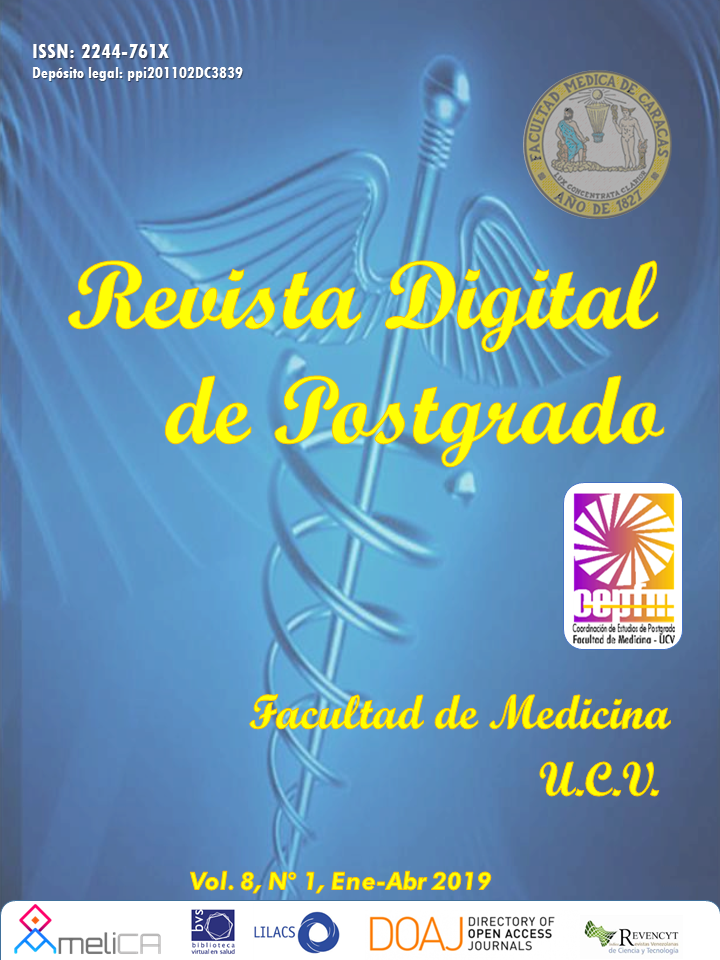Vesical gossypiboma: Report of 2 cases and review of the literature
Keywords:
bladder foreign body, gauze, gossypiboma, simple prostatectomy, abdominal hysterectomy.Abstract
The presence of intracavitary gauzes after the surgical procedures is a situation that generates important complications, with serious medico-legal repercussions. The objective of this study is describe the presence of a bladder foreign body as an iatrogenic complication. Two cases are presented, the first is from a 63-year-old man with a history of simple prostatectomy for benign prostatic hyperplasia who presents with episodes of acute urinary retention; and the second is a 65-year-old woman with a history of abdominal hysterectomy due to leiomyomatosis that presents with chronic pelvic pain and recurrent urinary tract infections. A pelvic ecosonogram was performed on the patients who reported a bladder space-occupying lesion, urotac showed an intravesical foreign body with a radiopaque appearance, and intravesical synthetic flotation material was visualized in the urethrocystoscopy. The patient underwent a cystotomy with gas-compatible material extraction and the patient underwent endoscopic extraction, both showing a satisfactory evolution. Surgical site revision and transoperative gauze infection before the final synthesis of tissues is a fundamental step for the success of pelvic surgery.Downloads
References
Mannan A, Anwar S, Qayyum A, Tasneem RA. Foreign bodies in the urinary bladder and their management: a Pakistani experience. Singapore Med J. 2011; 52(1): 24-28.
Rafique M. Intravesical foreign bodies: review and current management strategies. Urol J. 2008; 5 (4): 223-231.
Khanna S, Pokhrel H, Basnet N, Chuni N. Gossypiboma - a case report. J Nepal Med Assoc. 2003; 42: 364-365
Mungadi A, Attahiru N, Saidu S. vesical gossypiboma mimicking calculus: a report of two cases. African J Urol. 2007; 13 (2): 136-138
Siddiqui Z, Naeem M. Gossypiboma bladder: the need to count sponges. J Pak Med Stud. 2011; 1 (1): 19-21.
Javanmard B, Yousefi MR, Fadavi B, Fallah Karkan M. Retained surgical gauze presenting with gross hematuria: a case report. Urol J. 2017 Aug 29;14(5):5027-5029.
Shimokihara K, Kawahara T, Hayashi Y, Tsutsumi S, Takamoto D, Mochizuki T, et al. Foreign body in the bladder: A case report. Int J Surg Case Rep. 2017; 32:22-24.
Rafique M. Vesical gossypiboma. J Coll Physicians Surg Pak. 2003, 13(5):293-295.
Singh P, Panaiyadiyan S, Nayak B. Pelvic gossypiboma with spontaneous intravesical erosion. BMJ Case Rep. 2017 Apr 11;2017
Joshi N, Kumar R, Yadav V. Gossypiboma in the urinary bladder: Time to make new surgical guidelines. Med J DY Patil Univ. 2014; 7 (4): 489-491.
Kansakar R, Hamal B. Cystoscopic removal of an intravesical gossypiboma mimicking a bladder mass: a case report. J Med Case Rep. 2011; 5:579.
Nosher JL, Siegel R. Percutaneous retrieval of nonvascular foreign bodies. Radiology 1993; 187(3):649-651.
Soomro HU, Jalbani I, Faruqui N. Intravesical Foreign Body: Tertiary care center experience from Pakistan. J Pak Med Assoc. 2016 Oct;66(Suppl 3) (10):S131-S133.
How to Cite
Issue
Section
License
Usted es libre de:
- Compartir — copiar y redistribuir el material en cualquier medio o formato
- Adaptar — remezclar, transformar y construir a partir del material
- para cualquier propósito, incluso comercialmente.
Bajo los siguientes términos:
-
Atribución — Usted debe dar crédito de manera adecuada, brindar un enlace a la licencia, e indicar si se han realizado cambios. Puede hacerlo en cualquier forma razonable, pero no de forma tal que sugiera que usted o su uso tienen el apoyo de la licenciante.
- No hay restricciones adicionales — No puede aplicar términos legales ni medidas tecnológicas que restrinjan legalmente a otras a hacer cualquier uso permitido por la licencia.











